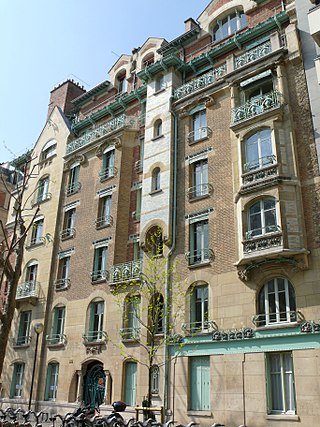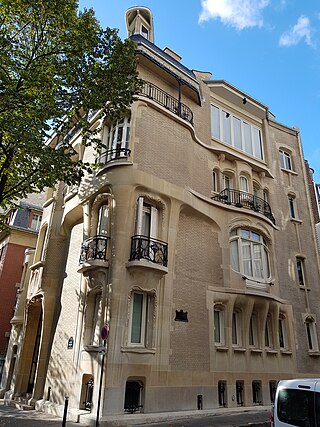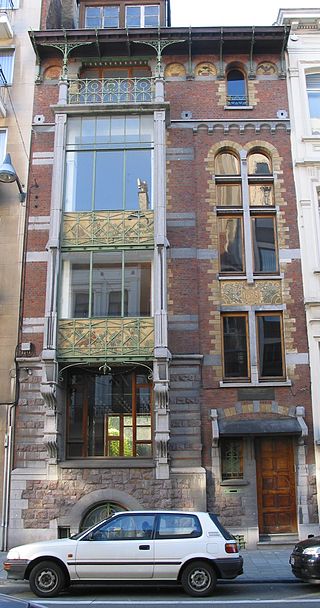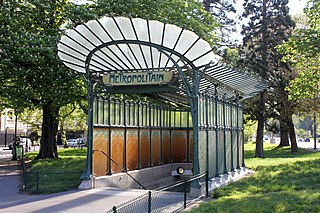
Art Nouveau is an international style of art, architecture, and applied art, especially the decorative arts. It was often inspired by natural forms such as the sinuous curves of plants and flowers. Other characteristics of Art Nouveau were a sense of dynamism and movement, often given by asymmetry or whiplash lines, and the use of modern materials, particularly iron, glass, ceramics and later concrete, to create unusual forms and larger open spaces. It was popular between 1890 and 1910 during the Belle Époque period, and was a reaction against the academicism, eclecticism and historicism of 19th century architecture and decorative art.

Hector Guimard was a French architect and designer, and a prominent figure of the Art Nouveau style. He achieved early fame with his design for the Castel Beranger, the first Art Nouveau apartment building in Paris, which was selected in an 1899 competition as one of the best new building facades in the city. He is best known for the glass and iron edicules or canopies, with ornamental Art Nouveau curves, which he designed to cover the entrances of the first stations of the Paris Metro.

Victor Pierre Horta was a Belgian architect and designer, and one of the founders of the Art Nouveau movement. He was a fervent admirer of the French architectural theorist Eugène Viollet-le-Duc and his Hôtel Tassel in Brussels (1892–93), often considered the first Art Nouveau house, is based on the work of Viollet-le-Duc. The curving stylized vegetal forms that Horta used in turn influenced many others, including the French architect Hector Guimard, who used it in the first Art Nouveau apartment building he designed in Paris and in the entrances he designed for the Paris Metro. He is also considered a precursor of modern architecture for his open floor plans and his innovative use of iron, steel and glass.

Sentier is a station on Line 3 of the Paris Métro in the 2nd arrondissement.

Jules Aimé Lavirotte was a French architect who is best known for the Art Nouveau buildings he created in the 7th arrondissement in Paris. His buildings were known for his imaginative and exuberant decoration, and particularly for his use of sculpture and glazed ceramic tiles on the facades, made in collaboration with leading sculptors and the ceramic manufacturer Alexandre Bigot. He was three times awarded prizes by the city of Paris for the most original facades, for the Lavirotte Building at 29 Avenue Rapp (1901), for the Ceramic hotel, 34 Avenue de Wagram (1904), and for the building at 23 avenue de Messine in 1907.

Henri Sauvage was a French architect and designer in the early 20th century. He was one of the most important architects in the French Art nouveau movement, Art Deco, and the beginning of architectural modernism. He was also a pioneer in the construction of public housing buildings in Paris. His major works include the art nouveau Villa Majorelle in Nancy, France and the art-deco building of the La Samaritaine department store in Paris.

Alexandre Bigot was a French ceramicist. He was primarily a ceramics manufacturer, producing the designs of many artists and architects of the French Art Nouveau movement, including: Jules Lavirotte, Hector Guimard, Louis Majorelle, Henri Sauvage, Henry van de Velde, Auguste Perret, Andre Arfvidson, Anatole de Baudot and more.

The Villa Majorelle is a house located at 1 rue Louis-Majorielle in the city of Nancy, France, which was the home and studio of the furniture designer Louis Majorelle. It was designed and built by the architect Henri Sauvage in 1901-1902. The villa is one of the first and most influential examples of the Art Nouveau architectural style in France. It served as a showcase for Majorelle's furniture and the work of other noted decorative artists of the period, including ceramist Alexandre Bigot and stained glass artist Jacques Gruber. It is now owned by the city of Nancy, and is open to the public certain days for tours by reservation.

The architecture of Paris created during the Belle Époque, between 1871 and the beginning of the First World War in 1914, was notable for its variety of different styles, from neo-Byzantine and neo-Gothic to classicism, Art Nouveau and Art Deco. It was also known for its lavish decoration and its imaginative use of both new and traditional materials, including iron, plate glass, colored tile and reinforced concrete. Notable buildings and structures of the period include the Eiffel Tower, the Grand Palais, the Théâtre des Champs-Élysées, the Gare de Lyon, the Bon Marché department store, and the entries of the stations of the Paris Metro designed by Hector Guimard.

The Castel Béranger is a residential building with thirty-six apartments located at 14 rue de la Fontaine in the 16th arrondissement of Paris. It was designed by the architect Hector Guimard, and built between 1895 and 1898. It was the first residence in Paris built in the style known as Art Nouveau.

The House and Workshop of master glassmaker Sterner in Brussels, Belgium, is the former town house and workshop of the master glassworker Clas Grüner Sterner. It was designed by the architect Ernest Delune, and built between 1893 and 1902, in Art Nouveau style.

The Lavirotte Building, an apartment building at 29 Avenue Rapp in the 7th arrondissement of Paris, France, was designed by the architect Jules Lavirotte and built between 1899 and 1901. The building is one of the best-known surviving examples of Art Nouveau architecture in Paris. The facade is lavishly decorated with sculpture and ceramic tiles made by the ceramics manufacturer Alexandre Bigot. Lavirotte was awarded the prize for the most original new facade in the 7th arrondissement in 1901.
The concours de façades de la ville de Paris was an architecture competition organized by the city of Paris at the very end of the 19th century.

Hôtel Guimard is an Art Nouveau town house built in 1909–1912 by Hector Guimard for use as his home and architectural studio, with a studio for his wife, the painter Adeline Oppenheim Guimard. It is considered one of the best surviving examples of his mature style. The house is located at 122 Avenue Mozart in the 16th arrondissement of Paris, France.

The Art Nouveau movement of architecture and design first appeared in Brussels, Belgium, in the early 1890s, and quickly spread to France and to the rest of Europe. It began as a reaction against the formal vocabulary of European academic art, eclecticism and historicism of the 19th century, and was based upon an innovative use of new materials, such as iron and glass, to open larger interior spaces and provide maximum light; curving lines such as the whiplash line; and other designs inspired by plants and other natural forms.

The Hankar House is a historic town house in Brussels, Belgium. It was designed by the architect Paul Hankar, and built in 1893, in Art Nouveau style. It is generally considered one of the first buildings in that style, along with the Hôtel Tassel by Victor Horta, built at the same time, because of its highly innovative plan and its ground-breaking use of materials and decoration.

The Art Nouveau movement of architecture and design flourished in Paris from about 1895 to 1914, reaching its high point at the 1900 Paris International Exposition. with the Art Nouveau metro stations designed by Hector Guimard. It was characterized by a rejection of historicism and traditional architectural forms, and a flamboyant use of floral and vegetal designs, sinuous curving lines such as the whiplash line, and asymmetry. It was most prominent in architecture, appearing in department stores, apartment buildings, and churches; and in the decorative arts, particularly glassware, furniture, and jewelry. Besides Guimard, major artists included René Lalique in glassware, Louis Majorelle in furniture, and Alphonse Mucha in graphic arts, It spread quickly to other countries, but lost favor after 1910 and came to an end with the First World War.

The whiplash or whiplash line is a motif of decorative art and design that was particularly popular in Art Nouveau. It is an asymmetrical, sinuous line, often in an ornamental S curve, usually inspired by natural forms such as plants and flowers, which suggests dynamism and movement. It took its name from a woven fabric panel called "Coup de Fouet" ("Whiplash") by the German artist Hermann Obrist (1895) which depicted the stems and roots of the cyclamen flower. The panel was later reproduced by the textile workshop of the Darmstadt Artists Colony.

The Art Deco movement of architecture and design appeared in Brussels, Belgium, immediately after World War I when the famed architect Victor Horta began designing the Centre for Fine Arts, and continued until the beginning of World War II in 1939. It took its name from the International Exposition of Modern Decorative and Industrial Arts held in Paris in 1925. At the end of World War II, Art Deco in Brussels faded to make way for the modernist and international architectural styles that would mark the postwar period.


















